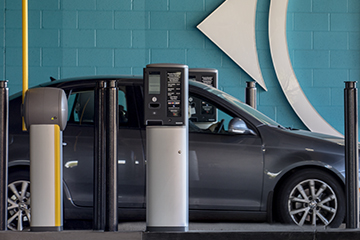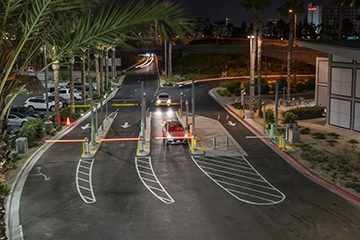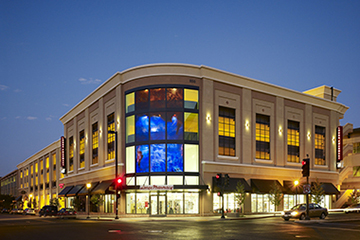Parking Magazine: Technology is Changing the Way We Park
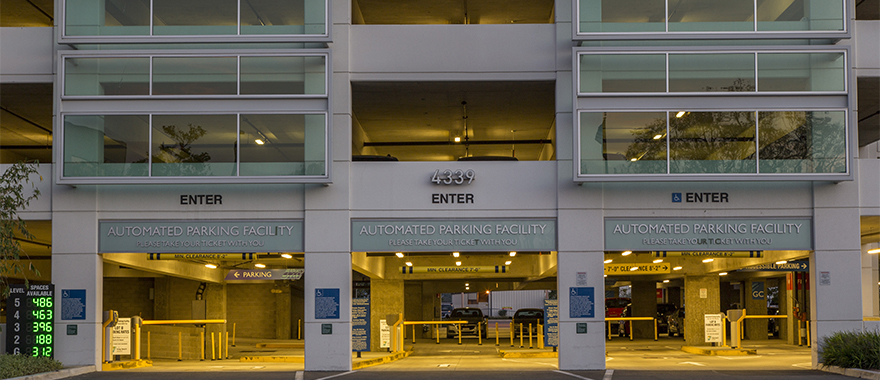
We’ve all been there. Within sight of our destination, the only thing standing between us and an important meeting or an appointment is parking. But instead of pulling into an open space and getting on with our day, we are confronted with row upon row of cars, no empty stalls in sight. So we circle. And circle. By the time we have finally found a place to park, we’re late for our engagement, irritated, and have started out our journey with a sour taste in our mouth.
We’ve all experienced frustration like this when it comes to parking, be it finding an open space, paying for parking or finding our way around a confusing parking layout, and that frustration doesn’t simply affect the parker. When someone can’t find a parking space, they’re late to work, doctor appointments, business meetings, gatherings with friends... The ripple effect of these delays not only impacts the schedules of the people we interact with, but the negative attitude we developed in the parking lot can color those interactions as well.
Cutting-edge parking technology on the market today can help change that. State-of-the-art Parking Guidance Systems (PGS) that guide users to a parking space, Parking Access and Revenue Control Systems (PARCS) that significantly boosts operational efficiencies and mobile apps that help users reserve and pay for parking can significantly improve the parking experience.
Follow the Guiding Light
If you have parked at one of the big casinos in Las Vegas lately, or made an appointment at a medical center like UC Davis, you might have had a different kind of parking experience. At these destinations, as well as many others, drivers are greeted with a message board upon entering the parking structure that lists the number of spaces available on each level. Inside, users are aided by signage in the aisles that points to available spaces. Once users turn down a row they are guided by a green light above available spaces. This individual stall counting system substantially enhances the user’s ability to find a parking space, which is good news when it comes to utilization. Standard parking facilities are often considered to be at capacity when 85% occupied, as this is the tipping point where most users hunting for an open space assume there are none available. However, PGS can increase that utilization to 100%. The bottom line? No more circling for that elusive space.
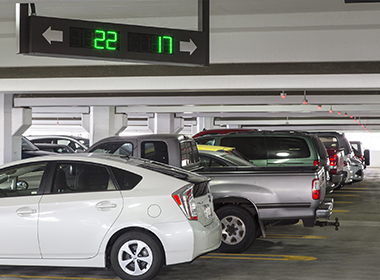 PGS can be customized to provide data on the availability of an entire facility, by floor, by aisle and by space
PGS can be customized to provide data on the availability of an entire facility, by floor, by aisle and by space
PGS systems like the one at UC Davis Medical Center utilize overhead mounted ultrasonic directional sensors and delineation posts, single space sensors, magnetic field sensors or in-ground loops to collect proper vehicle counts. The count data is collected by controllers and transmitted via radio frequency, wireless communication or fiber optics to a server that can then display the information on strategically placed signage to display real time parking availability that directs drivers right to an open stall.
PGS displays can be installed to provide data on the availability of an entire facility, by floor, by aisle and by space, all highly customizable to fit the needs and budget of an individual structure and user group. PGS systems can even be networked between structures. In the city of San Jose, visitors are aided by a dynamic, integrated PGS that proves real time availability for over 6,000 stalls in the City’s eight downtown parking structures.
High Tech Efficiency
The days of digging for quarters to feed a meter or cramming a five dollar bill into a slot in a surface lot are all but obsolete. Today’s PARCS utilize sophisticated technology such as proximity card readers, RFID, license plate recognition software and wireless technology to solve parking challenges from operational efficiency to throughput to segregation of user groups. The options are plentiful, and have the potential to not only improve management and enforcement, but also customer satisfaction. Determining which system is right for any particular facility depends on a variety of factors. What user groups are being catered to? What are their needs? Do certain users need to be isolated from others? Are they regulars who are familiar with a facility, or are they sporadic visitors who create higher safety and wayfinding concerns?
If you are a resident of one of several Equity Residential apartment developments in the San Francisco area, your parking permit might be an RFID sticker on your windshield. Parking facilities designed for residential and office buildings typically experience low turnover with regular users who understand the facility and the technology it employs. Therefore a transponder attached to their vehicle or a keycard can provide easy, convenient entry and exit without expensive equipment or parking attendants, benefiting both residents and parking operations.
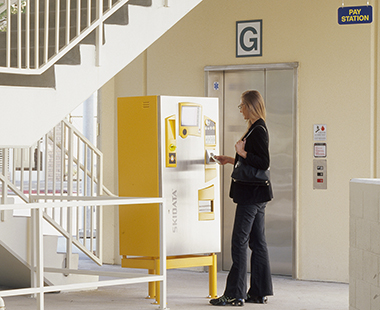 Pay-on-Foot stations reduce or eliminate the overhead costs associated with a parking attendant
Pay-on-Foot stations reduce or eliminate the overhead costs associated with a parking attendant
Parking facilities that cater to users with higher turnover, such as retail shoppers, restaurant goers and medical patients, require a different approach. Traditionally that approach has been to have users pay a parking attendant. Though still a viable solution, it comes with high operating and equipment costs. Alternatives such as pay on foot and central pay stations can offer much lower maintenance costs and provide users convenient ways to pay for parking while speeding up throughput by not requiring drivers to stop and get a ticket before proceeding to a parking space. Because you can’t count on drivers to have the familiarity with these systems, clear, plentiful signage is a must. Regardless of the user group, license plate recognition software can be linked to security systems to reduce theft and aid in the recovery of stolen cars.
Street parking may still use the traditional meter, but it’s a meter with a lot of upgrades. In addition to being programmed with multiple payment solutions, including credit cards, smart cards and contactless payments, single space meters can utilize wireless technology to communicate with sensors and transfer data to a central data management system. These “smart meters” also allow operators to balance supply and demand by adjusting parking rates as needed. The benefit? Operators can easily monitor parking trends and adjust their programs and pricing accordingly, which increases flexibility and functionality while also increasing revenue and providing greater customer satisfaction.
There’s An App for That
The next time you head to the airport, instead of fighting for a parking space, what if you could pull out your phone and reserve a place to park as soon as you’ve booked your ticket? Soon you’ll be able to do just that at the San Diego International Airport. The Terminal 2 Parking Plaza, currently under construction, will offer a mobile app for patrons who want to reserve parking in advance. Mobile apps are already available that allow users to pay for parking and even add extra time to pre-paid parking if they choose to linger at their destination longer than expected.
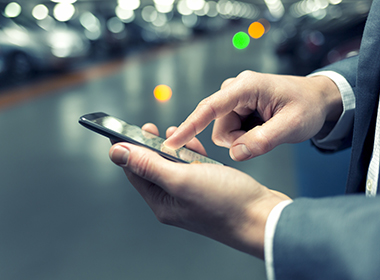 Mobile apps can allow users to reserve and pay for parking, as well as provide an opportunity to integrate parking into the overall experience
Mobile apps can allow users to reserve and pay for parking, as well as provide an opportunity to integrate parking into the overall experience
Apps can also serve a broader purpose, integrating parking as part of the overall experience. Medical centers can leverage this type of technology to provide patients with appointment reminders, travel routes and parking information, taking the stress out of getting to their appointment while also reducing delays in the waiting room as more patients arrive on time.
At Lumina Towers in San Francisco, which offers valet parking to tenants, residents can request their vehicles via app, making retrieving their car as simple as arriving at the pick-up area, obtaining the keys and driving away. The city of Laguna Beach offers a mobile app to point visitors towards public lots, provide parking tips, and even offer live updates on a complimentary trolley service aimed to reduce congestion.
Integrating smart phones and parking via Bluetooth is also becoming more prevalent. Bluetooth connectivity can provide a means for customers, residents or employees to gain entry to a parking facility and pay for parking. Retailers and restaurants can also leverage this technology to provide parking validation, streamlining the process and making it more efficient.
The latest developments in parking technology offer new and innovative ways to improve the parking experience. More and more parking owners and operators are seeing the value in integrating cutting-edge technology to improve customer service while also adding to their bottom line. Because this technology is so customizable, there is a solution for every scenario, all with the power to make parking a better experience for all.




